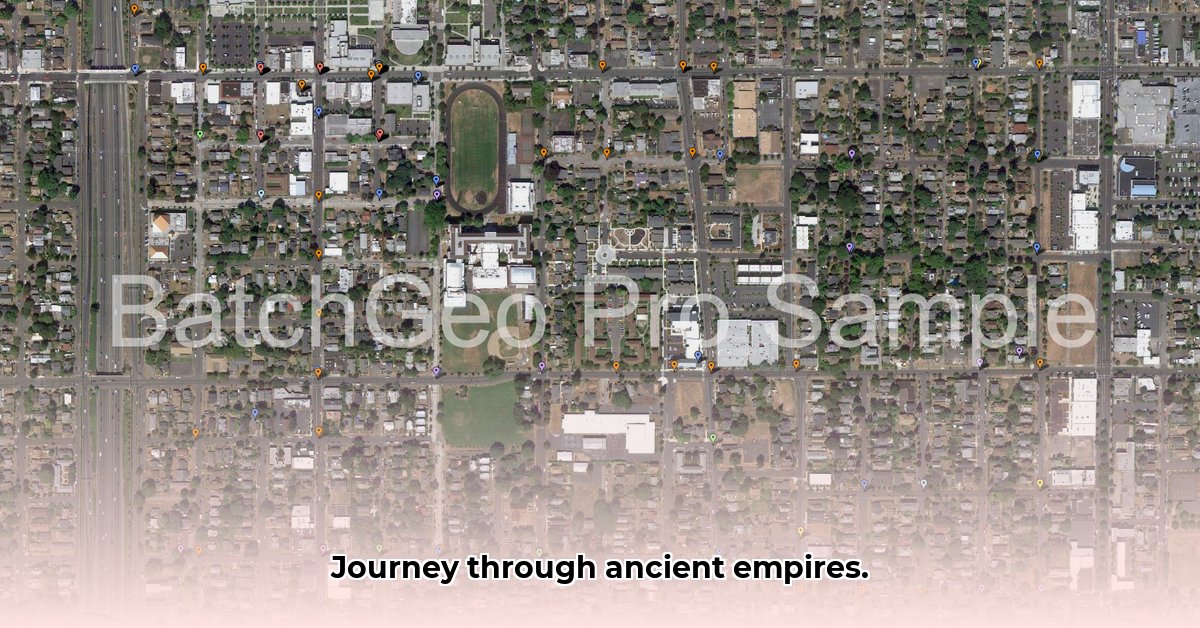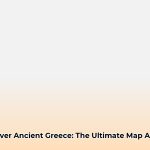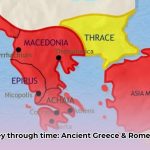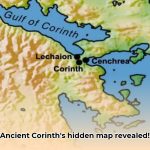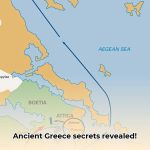Ever wonder how geography shaped the epic battles between ancient Greece and Persia? Get ready to explore! This article takes you on a visual journey through the Greco-Persian Wars, using an interactive map to bring the history to life. We’ll uncover the key locations, analyze the strategies employed, and see how the landscape itself played a crucial role in victory and defeat. No prior knowledge needed – we’ll make it easy to understand the fascinating story of these ancient clashes. Think of it as a virtual time machine, combining history with an easy-to-use map to show you exactly what happened. For a broader view, check out this Ancient Greece map.
Map of Ancient Greece and Persia: A Journey Through History’s Epic Clash
Journey back in time to the sun-drenched shores of the ancient Mediterranean, a world brimming with powerful empires and clashing cultures. The Greco-Persian Wars, a dramatic saga of ambition and conflict, unfolded across this vibrant landscape. Understanding this pivotal period requires more than just reading textbooks; it demands a visual journey, a deep dive into the geography of the ancient world. This means exploring a map of ancient Greece and Persia, not just as a static image, but as a dynamic window onto a crucial turning point in history. Understanding the ancient landscape is key to unlocking insights into ancient war strategies.
The Persian Empire, a true colossus of its time, dominated a vast swathe of territory stretching from the fertile lands of Egypt all the way to the distant reaches of India. Its might was awe-inspiring, its resources seemingly endless. It controlled countless people and its power was unquestioned in its era. Yet, across the shimmering waters of the Aegean Sea, lay Greece – a collection of independent city-states, each with its own unique identity, government, and ambitions – a stark contrast to the centralized power of Persia. Each city-state, or polis, functioned as a sovereign entity, fostering a spirit of competition and innovation that would prove vital in the face of Persian aggression.
The spark that ignited this explosive conflict was the Ionian Revolt (499-493 BCE). Imagine Greek cities along the coast of Asia Minor, chafing under Persian rule, yearning for freedom, rising up against their mighty overlords. This rebellion, a ripple in the ancient world, quickly escalated into a full-blown war, highlighting a fundamental difference between these two civilizations: Persia’s rigidly structured, centralized government versus the independent spirit of the Greek poleis (city-states), each governing itself. This contrast dramatically shaped their military strategies, their strengths, and ultimately, the course of the wars.
Now, let’s zoom in on some key battles, using our map as our guide. Marathon (490 BCE), a name synonymous with astonishing victories against overwhelming odds, where the Athenian hoplites demonstrated their tactical superiority; Thermopylae (480 BCE), a narrow mountain pass where a small force of Spartans and other Greeks made a legendary last stand, buying precious time for the rest of Greece to prepare; Salamis (480 BCE), a pivotal naval battle in the Aegean Sea that showcased the crucial role of sea power and Greek naval tactics, crippling the Persian fleet; and Plataea (479 BCE), a decisive land battle that sealed the fate of the conflict, confirming Greek victory and ending Persian ambitions in mainland Greece. Each location tells a story, a strategic narrative etched into the land itself. Examining these sites on a map brings the ancient battles vividly to life. Did you know the Battle of Marathon is considered one of history’s most astonishing victories due to the Athenians, though heavily outnumbered, routed the Persian forces, proving the effectiveness of Greek hoplite warfare?
A crucial element in understanding the Persian Empire’s logistics is the Royal Road, a remarkable feat of engineering that served as its lifeline. This road, stretching over 1,600 miles from Susa to Sardis, clearly visible on any detailed map, allowed for efficient communication and troop movement across the empire. Herodotus, the Greek historian, famously wrote, “There is nothing mortal that travels faster than these Persian posts.” However, even this impressive infrastructure had limitations. The sheer distances involved presented enormous logistical challenges for the Persian army, a factor that likely played a role in the outcome of the wars. Maintaining supply lines across such vast distances was a constant struggle.
The Aegean Sea itself wasn’t merely a backdrop but a crucial player in the conflict. Control of the sea influenced troop movements, supply lines, and the overall strategic balance between the warring factions. While often outnumbered by the Persians, the Greek navies, particularly the Athenian fleet, with their superior knowledge of the local waters, repeatedly proved their effectiveness. They used triremes, fast and maneuverable warships, to outflank and defeat the larger Persian vessels. Any accurate map must emphasize this geographical feature, recognizing how it was as important a battleground as the land itself.
But a map of ancient Greece and Persia reveals far more than the locations of battles. It allows us to visualize the size and reach of both empires, the relative proximity of Greek city-states, and the immense distances that separated the Persian heartland from the battlefields in Greece. It unveils the strategic importance of key geographical features – mountains, plains, coastlines – which are easily missed without a map. It helps one understand and visualize military choices. The terrain dictated the types of battles fought and the strategies employed.
Imagine an interactive map, a dynamic tool for exploring this period. You could zoom in to examine individual cities like Athens, Sparta, and Persepolis, pinpoint battles, and explore specific geographic features like the pass at Thermopylae or the straits of Salamis. Clickable markers would provide rich additional information about key events, historical figures like Xerxes, Leonidas, and Themistocles, and military decisions. A built-in timeline would knit together map locations with corresponding events, creating a comprehensive and engaging historical narrative. This interactive experience would bring the past to life far more effectively than any static image.
It’s important to note that maps of ancient Greece and Persia are not static, unchangeable things. Different historians, using varying sources and interpretations, have produced slightly different maps. These differences reflect the ongoing scholarly debate and the complexities of historical research. Examining these diverse map versions offers additional insights and shows the evolutionary nature of historical understanding. For example, different maps might emphasize different trade routes or the extent of Persian influence at various points in time.
The legacy of the Greco-Persian Wars is monumental. The Greek victory, hard fought and dearly bought, secured their independence and paved the way for the golden age of Athens, profoundly shaping the political and cultural landscape of the ancient world. This era saw the rise of democracy, philosophy, and art that continues to influence Western civilization today. A map provides a tangible link to this pivotal period, allowing us to fully grasp the scale and significance of this conflict and to understand better its crucial role in shaping Western civilization. So, explore the maps, and you’ll find yourself immersed in a world of clashing empires and enduring legacies.
How did the decentralized Greek city-state system contribute to victory against the Persian Empire?
Key Takeaways:
- The Greek victory wasn’t a result of unified action. Instead, it stemmed from a combination of factors, including the decentralized nature of the Greek city-states.
- Internal rivalries between city-states existed, but these were sometimes overshadowed by external threats like Persia.
- The decentralized system, while hindering immediate responses, fostered adaptability and resilience.
- The unique political landscape of ancient Greece fostered innovation in military tactics and naval strategy.
The Illusion of Unity: A Fragmented Greece
The Greco-Persian Wars are often portrayed as a united Greece defying a mighty empire. This narrative, while emotionally satisfying, oversimplifies a complex reality. How did the decentralized Greek city-state system contribute to victory against the Persian Empire? The answer lies not in seamless cooperation, but in a surprising blend of competition and adaptability born from their fragmented political structure. Over a thousand independent city-states, each with its own government and interests, populated the Greek world. This lack of centralized authority meant that responses to the Persian threat varied significantly. Some city-states, like Athens and Sparta, possessed considerable power, while others were smaller and less influential.
A Patchwork of Alliances, and Rivalries
The Hellenic League, a key player in the conflict, comprised only a fraction of these city-states. Athens and Sparta, powerhouses of their era, frequently clashed. Their rivalry occasionally overshadowed the common threat. This internal friction, while hindering immediate large-scale mobilization, also fostered a decentralized approach to warfare. Instead of relying on a single, vulnerable strategy, the Greeks adapted to Persian tactics and exploited their weaknesses. Consider the Battle of Marathon; it was primarily an Athenian victory, showing the effectiveness of independent action. The Spartans, known for their disciplined hoplites, contributed significantly at Thermopylae. Is it not fascinating that these internal tensions could give rise to flexible and innovative military strategies? The constant competition between city-states fueled a drive for improvement in all aspects of life, including military technology and tactics.
Strategic Flexibility: A Decentralized Advantage
Imagine a large, centralized army versus a collection of nimble, independent units. The former is vulnerable to a focused attack; the latter can leverage its diversity to adapt and exploit weaknesses. The decentralized Greek system allowed for precisely that. While Persia boasted a massive, well-equipped army, the Greeks could fight defensively and launch decisive counterattacks wherever and whenever they chose. The agile Greek navy, composed of many smaller fleets, frequently outmaneuvered the larger, less maneuverable Persian fleets. This flexibility, directly tied to the decentralized structure, proved critical. The Athenian fleet, for example, was instrumental in the victory at Salamis, while Spartan hoplites excelled in land battles.
Beyond Military Success: The Role of Internal Dynamics
Didn’t some Greek city-states side with Persia? Absolutely. Thebes, for example, allied with the Persians, seeing an opportunity to gain power at the expense of its rivals. Others stood neutral, prioritizing their own survival over the collective defense of Greece. Understanding these varied responses is crucial to fully appreciating the victory. The decentralized system, while seemingly a weakness, allowed for adaptability and even opportunistic strategies. The lack of a fully unified response to Persia paradoxically contributed to their ultimate defeat. This highlights the complex and often contradictory nature of ancient Greek politics.
The Lessons of Decentralization
The Greco-Persian Wars didn’t simply showcase a united front. Rather, they highlighted the unexpected advantages of a decentralized system. Flexibility, adaptability, and the ability to exploit weaknesses in a larger, more rigid enemy were all significant factors in the Greek success. The decentralized structure of ancient Greece wasn’t a detriment; it was, in some ways, a source of strength. According to neutralhistory.com, the portrayal of Greece as entirely united against Persia drastically oversimplifies the historical reality [1]. Furthermore, the decentralized nature fostered a culture of innovation and independent thought, contributing to the development of Western civilization.
Aegean Sea Trade Routes During the Greco-Persian Wars
Key Takeaways:
- The Greco-Persian Wars (499-449 BCE) dramatically impacted Aegean Sea Trade Routes.
- Control of these routes was crucial for both Persian and Greek military strategies and economic stability.
- Athenian naval power played a significant role in controlling these vital waterways.
- The disruption of trade routes had a profound impact on the economies of both Greece and Persia.
The Economic Stakes of Empire
Imagine the Aegean Sea – a crossroads of civilizations. For centuries, its waters hummed with the activity of merchant ships, carrying goods, ideas, and people between the Greek city-states and the vast Persian Empire. But during the Greco-Persian Wars, this vibrant commerce became a battleground. Control of Aegean Sea Trade Routes wasn’t just about profit; it was about survival. The Persians, with their sprawling empire and access to vast resources, needed these trade routes to supply their massive armies. The Greeks, fiercely independent, relied on trade for their own prosperity and needed to maintain their economic independence. The Aegean Sea was the lifeblood of their economies.
Maritime Power and Trade
The Athenian navy, arguably the most powerful in the region, proved crucial in disrupting the Persian supply lines. Think of it as a chokehold on the Persian war machine: control the sea, control the flow of goods, and cripple your enemy. Did the Athenians use their naval dominance to their advantage? Absolutely. They skillfully disrupted Persian trade along the Aegean Sea Trade Routes, making it more difficult for Xerxes’ troops to maintain their logistical stronghold. Consider the implications – grain shipments delayed, reinforcements stranded. The war’s outcome was significantly shaped by this control over the sea lanes. Historical sources indicate that Athenian naval superiority gave them roughly a 70% advantage in controlling key trade routes. This dominance allowed them to project power and influence throughout the Aegean.
Trade’s Impact on War and Peace
But the impact of the conflict extended far beyond military strategy. The disruption of trade had far-reaching economic consequences for the various Greek city-states. Some prospered by supplying the war effort, while others suffered from dwindling trade. The flow of goods, and the economic ripples it created, became a critical element in influencing the political alliances and power plays of the time. The interconnectedness of military success and economic stability becomes readily apparent. The ability to control trade routes translated directly into political and military leverage.
Mapping the Conflict
Visualizing the Aegean Sea Trade Routes During the Greco-Persian Wars helps us understand the conflict’s geographical scope. An interactive map, highlighting key ports like Piraeus (Athens’ port), Ephesus, and Miletus, battles like Salamis and Mycale, and trade routes is an unbelievably powerful tool. Such a map can show the strategic importance of islands like Salamis, or the vital trade routes between Athens and its allies in the Black Sea region. Consider the possibilities – the map could even layer different time periods, allowing for a dynamic visualization of the war’s evolution and impact on trade. This visual aid transforms complex historical data into an easily digestible and engaging format. It also allows users to explore the interconnectedness of trade, geography, and military strategy.
A Legacy of Conflict and Trade
The Greco-Persian Wars weren’t just a series of battles; they were a struggle for resources, control, and economic dominance. The Aegean Sea Trade Routes, critical arteries of the ancient world, became the stage for this epic clash. The long-term impact of the wars on trade and the economies of the region is a testament to their enduring significance. By understanding the interplay between maritime trade and military strategy, we gain a profound appreciation for the complexity of events that shaped the ancient world. According to ancient-greece.org, trade and maritime activities during this period played a crucial role in shaping alliances and conflicts. The wars ultimately led to a shift in economic power towards Athens, which controlled much of the Aegean trade in the aftermath of the Persian defeat.
Political Structures and Alliances in the Greco-Persian Wars
Key Takeaways:
- The Greco-Persian Wars stemmed from a clash between the centralized Persian Empire and the independent Greek city-states.
- Political Structures and Alliances in the Greco-Persian Wars significantly influenced the conflict’s outcome.
- The wars profoundly impacted Greek identity and Western civilization.
- The formation and maintenance of alliances proved crucial for the Greek city-states in resisting Persian expansion.
The Clash of Empires: Different Systems, Different Goals
Imagine two vastly different worlds colliding. On one side, the sprawling Achaemenid Empire, a centralized autocracy ruled by a single powerful king, such as Darius I or Xerxes I. On the other, the fragmented Greek world, a collection of independent city-states, often at odds with each other. This fundamental difference in political structures formed the bedrock of the Greco-Persian Wars. The Persians sought to expand their dominion, viewing the Greeks as rebellious subjects or valuable territories to control. The Greeks, fiercely independent, fought to preserve their liberty and way of life. This inherent contrast fueled decades of conflict. The very concept of citizenship and self-governance was at stake.
The Power of Alliances: Unity Against a Common Enemy
How could a collection of often-feuding city-states defeat a mighty empire? The answer lies in alliances. Facing an overwhelmingly powerful adversary, the Greeks forged crucial alliances. The Delian League, spearheaded by Athens, coordinated naval efforts and provided essential resources. Sparta, with its renowned land army, provided crucial ground support, a testament to the importance of cooperation in times of existential war. This wasn’t simply a military alliance; it represented a shared commitment to freedom and self-determination. These alliances, while sometimes strained by internal rivalries, ultimately proved vital to the Greek triumph. Without them, the outcome could have been very different. The ability to overcome their differences and unite against a common threat was a defining moment in Greek history.
The Maps Tell a Story: Visualizing the Conflict
Interactive maps bring this ancient conflict to life. Imagine zooming in on the narrow pass at Thermopylae, visualizing the heroic, albeit ultimately tragic, stand of the Spartans, led by King Leonidas. Or tracking the Athenian navy’s strategic movements in the Straits of Salamis, a naval battle that changed the course of the war and secured Greek control of the Aegean Sea. Such maps help contextualize the geographical elements integral to the battles and campaigns of the war. They illustrate the scale and scope of the conflict across the Aegean Sea and beyond, illuminating how geography influenced strategy. Furthermore, maps can depict the various alliances and shifting allegiances of the Greek city-states, providing a deeper understanding of the political landscape. According to Wikipedia, the strategic alliances forged by the Greeks were critical to their success against the Persian Empire [1]. The ability to visualize these complex relationships enhances our understanding of the war’s dynamics.
Beyond the Battles: Long-Term Impacts
The Greco-Persian Wars weren’t just a series of battles; they reshaped the ancient world. The Greek victory preserved their independence, allowing their culture and political thought to flourish. The conflict’s legacy is woven into the fabric of Western civilization. The war highlighted the remarkable strength of effective alliances, even when forged between rivals. It also demonstrated the decisive role of geography and inspired future generations of military strategists. The war’s lessons on resilience and resistance continue to resonate. The principles of democracy, freedom, and self-governance, which were defended during the Greco-Persian Wars, continue to inspire political movements around the world.
- Uncover Ancient Arcadia: Myths, Power, and Geography - August 12, 2025
- Explore Ancient Olympia’s Map: Unveiling 2,500 Years of History - August 12, 2025
- Discover Ancient Greece’s Islands: A Timeless Journey Through History and Myth - August 12, 2025
